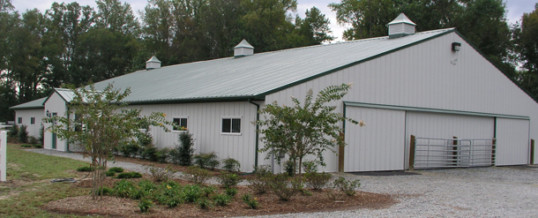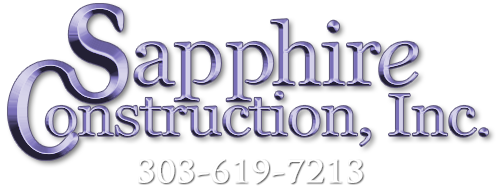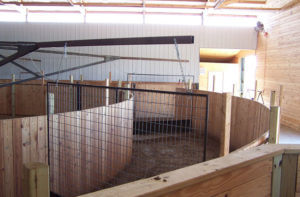
Equip your Riding Arena for any Horse Activity
While every riding arena needs the basics, the equipment needed for every equestrian sport differs. The philosophy of the trainer also affects the equipment list. Here will get you going by talking about several variables.
Basic Equipment Needs
Make your introduction to your new equestrian arena easy. Start gathering some basic equipment during construction. It sounds unexciting but you’ll need a poop scoop and a way to transport waste out of the arena. That could mean obtaining a muck bucket or a wheelbarrow. Then you’ll need equipment needed to smooth out the ground. Start with a rake. Then investigate a grater or other machinery to level the ground.
Simple Dressage and Jumping Equipment
If you are sharing your equestrian arena with others, you’ll want to have basic equipment on hand to support dressage and jumping. Dressage tests require the installation of proper letters. You can buy them in many styles and materials or make your own. Many stand alone. You can fix them to the wall, stick them into the soil, fastened them to cones, or paint them on the fences. Letters may help with other types of training, too.
Do you need the entire alphabet? The letters needed for dressage depend upon the size of your riding arena and the skill levels of the riders. For Introductory and Preliminary testing, be sure you have the capital letters for A, K, E, H, C, M, B, and F. You’ll need to add some more for tests starting with Elementary level: V, S, R, and P.
Dressage boards help mark out test areas in non-regulation sized arenas. Ready-made professional boards are available to fit different sizes of arenas. They come in full and half boards. If you have the tools, you can make them yourself.
Poles and Jumps for Riding Arenas
Horses respond well to poles during training. Even though they may not be training to jump, holes offer boundaries. They also provide trainers signal cues. Made from wood or plastic, online sources show many varieties. If you craft them yourself, make sure they are round or octagonal, rectangular, or square. 10-foot holes can be the most versatile. At times, trainers may also use a 4 foot pole or a 6 foot pole. However, you’ll be better off buying regulation poles if competitions are on the horizon.
Additional equipment needed for jumping varies according to the discipline. And you can be creative. Get wings, cups, blocks, fillers, planks, water tray for show jumping. The cups will need a track system. Most wings need cups, too. Jump blocks – pre-molded plastic stands – suffice for jumping at lower levels. Check out the equipment used at competitions and create your own variations of a wall, gate, a bright colored standing filler. You can use a big tarp and a couple of poles to improvise the water tray.
Fences
Working Hunter fences are one variation of this show jump fence. Normally they are more rustic looking and decorated with fillers that emulate brush and other obstacles encountered out in the natural environment.
Add some arena eventing fences both large and small arenas and schools to help with practices. This type of fence mimics cross country fences with brush and skinnies. Be sure to include some proper mobile cross country fences in the mix.
Additional Arena Equipment
Shows use many more props. Acclimate your horse to these kinds of objects. Pots of plastic flowers often decorate or highlight certain areas. You’ll see flags waving. How about banners and buntings? Put a few around your own equestrian facilities so they become common for the horses.
Another useful tool is the big mirror. It can help with training so you can see from another viewpoint. Arenas may feature interior mirrored wainscot covering an entire wall. Regardless of what you decide to do, remember these mirrors need to be safe.
Specialized Equipment
If you are undertaking natural horsemanship, you’ll use additional props. You’ll need barrels for racing in Western riding. For polo, you’ll need high kick boards for stray balls and goals. To add music, you’ll need speakers. How about obstacle course barrels, driving cones, ramps? Little by little you’ll figure out the best equipment for your situation. You also need places to store extra equipment. And that brings us to floorplans and design for equestrian buildings.
Design and Build a Riding Arena in Colorado
If you need a stable and/or an arena, let’s talk about the design. Call Allen Randa at Sapphire Construction, Inc. (303) 619-7213. We custom design every equestrian building using high-quality, engineer-tested materials from Lester Buildings.
NOV
2022


About the Author:
Allen Randa is a second generation Master Carpenter and Owner of Sapphire Construction Inc. Allen personally manages each project from beginning to end. That includes the first meeting, the estimate, the contract and architectural designs.